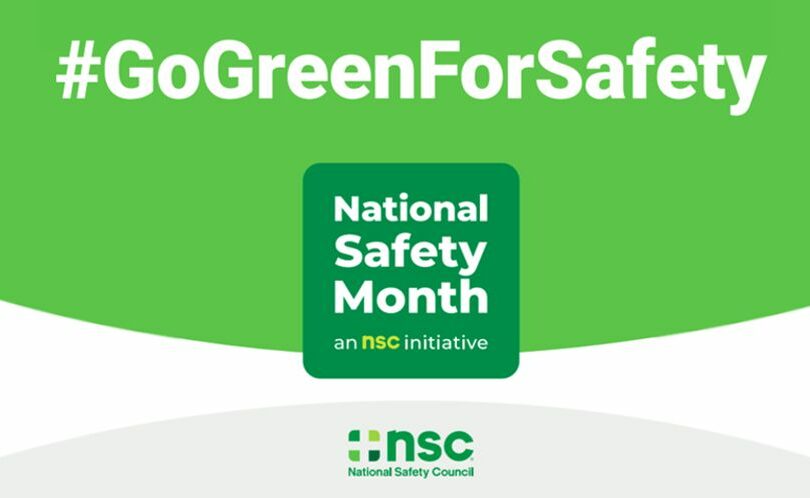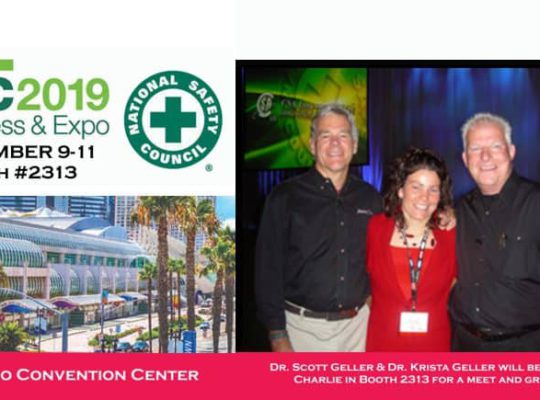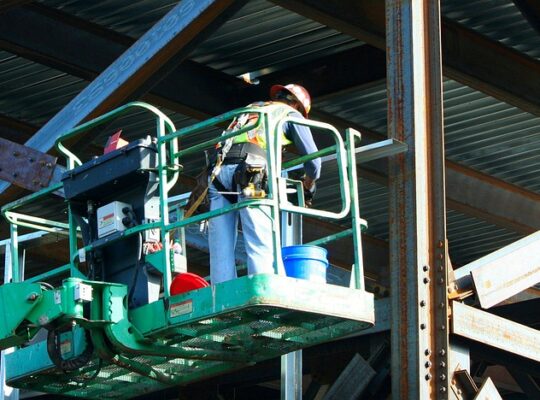Join us as we celebrate National Safety Month every June. While safety is crucial throughout the year, this month is dedicated to emphasizing the importance of preventing injuries and fatalities in all aspects of life, be it the workplace or anywhere else. In this blog, the National Institute for Occupational Safety and Health (NIOSH) and the National Safety Council (NSC) are showcasing their research and prevention initiatives focused on four themed areas, one for each week of the month: musculoskeletal disorders (MSDs), workplace impairment, injury prevention, and slips, trips, and falls.
We encourage you to help us raise awareness about safety. Follow along with our campaign activities week by week and actively participate as the month progresses.
Week 1 – Emergency Preparedness
NIOSH: The NIOSH Musculoskeletal Health Program is dedicated to reducing the impact of work-related MSDs through focused research and prevention efforts. Their program aims to safeguard workers, assist management in mitigating risks and liabilities, and aid practitioners in enhancing the effectiveness of workplace interventions. In a recent blog post, they summarize 50 years of NIOSH research dedicated to protecting workers from MSDs. NIOSH recognizes the role of technology in preventing MSDs and will be conducting a series of webinars highlighting emerging technologies like wearable devices, exoskeletons, and computer vision, which can effectively reduce work-related MSDs. If you want to learn more, visit the NIOSH website’s Ergonomics and Musculoskeletal Disorders section. We also offer a Back Injury Prevention Training Video Package for Employees that can be very helpful while targeting Ergonomics and Musculoskeletal safety at work.
NSC: Overexertion, such as lifting, pushing, pulling, holding, or carrying objects, along with bodily reactions, has long been the primary cause of work-related injuries and illnesses in the United States, with the exception of 2020 due to COVID-19. We believe that every worker deserves to be in an environment where their safety is valued and where risks of musculoskeletal disorders are identified and minimized. The NSC has undertaken significant initiatives to prevent these ergonomic injuries through the MSD Solutions Lab, and we are proud to have NIOSH as a founding member of our advisory council.
We urge companies and organizations to prioritize the protection of their most valuable assets—their workers. By taking the MSD pledge, you will join a growing community of employers committed to sharing ergonomic solutions and cutting-edge insights. This commitment will not only enhance the well-being of your workers but also grant you access to free tools, events, and training opportunities. It will strengthen your safety culture and enable you to assess your progress effectively.
Shifting NSC’s approach to MSD risks can provide relief to millions of workers and save employers the costs associated with physical and psychological disabilities. Moreover, many technologies that reduce MSD risks also enhance workers’ task performance, directly improving productivity. By investing in workplace safety, employers can enhance their bottom line, increase retention rates, reduce absenteeism, and ultimately improve the lives of workers both on and off the job site.
Week 2: Workplace Impairment
NIOSH: The opioid crisis has had a devastating impact on certain sectors of the U.S. workforce. Industries with high injury rates and physically demanding working conditions, such as construction, mining, and fishing, have experienced alarmingly high rates of opioid overdose deaths. Workplaces have a crucial role to play in improving the safety and well-being of workers. A recovery-supportive workplace aims to prevent work-related factors that contribute to or exacerbate substance use disorders while facilitating access to appropriate care and supporting sustained recovery. For more information on this topic, including resources on medication-assisted treatment and Naloxone, please visit the NIOSH opioid webpage.
Substance use or misuse is not the only work-related issue that can result in impairment in the workplace. Fatigue can affect workers across all occupations and industries, posing significant risks to safety and health. Fatigue can lead to slower reaction times, reduced attention and concentration, impaired short-term memory, and compromised judgment. Work-related fatigue is often associated with nonstandard schedules, such as night shifts and extended work hours, which can disrupt or shorten sleep. However, other factors such as physically demanding work, hot environments and confined spaces can also contribute to fatigue. To learn more about managing fatigue, including online training and fatigue detection technologies, please visit the NIOSH Center for Work and Fatigue Research.
NSC: Impairment has long been a significant workplace safety issue. However, the pandemic has ushered in a new era of workplace safety, with employers grappling with increased substance use and misuse, as well as heightened mental health concerns like depression and anxiety – conditions that are often interconnected. The pandemic has also adversely affected other causes of impairment, such as fatigue.
At NSC, we define impairment as the inability to function normally or safely due to various factors, including chemical substances (e.g., alcohol, opioids, cannabis), physical factors (e.g., fatigue and certain medical conditions), social factors (e.g., work-related stressors), and mental distress (e.g., mental illness and other related factors). According to a recent national employer survey conducted by NSC, over 90% of participants agree with this expanded definition of impairment. The survey also revealed that more than half of employers believe impairment is compromising the safety of their workforce. To assist employers, NSC provides a range of resources on impairment, including cost calculators for substance use, fatigue, and mental health, as well as toolkits on opioids, fatigue, and safe driving.
Week 3: Fostering Injury-Free Workspaces
The National Institute for Occupational Safety and Health (NIOSH) believes that a key to worker protection lies in controlling exposure to occupational hazards. By employing a well-structured system of controls, we can define feasible and effective strategies to safeguard employees. One significant step towards preventing occupational injuries, illnesses, and fatalities is to eliminate or reduce hazards and risks. Some initiatives to reduce high injury rates in certain industries and jobs include:
- NLE Calc, the NIOSH Lifting Equation mobile app, helps calculate risk indexes for single and multiple manual lifting tasks. This tool is designed to assess lifting tasks, estimate risks, and help decrease the occurrence of low back injuries in workers.
- The Aerial Lift Hazard Recognition Simulator aids in the prevention of injuries, fatalities, and falls related to aerial lifts. In the span of 2011-2014, the operation of aerial lifts led to the injury of 1,380 workers and the death of 87.
- The NIOSH Center for Motor Vehicle Safety supplies research-informed advice to avoid work-associated motor vehicle crashes- the primary cause of work-related deaths in the U.S.
– An infographic underscores risks faced by lawn care workers whose fatality rate is more than six times higher than the average worker.
The National Safety Council (NSC), in their Injury Facts report, stated that four million work-associated injuries needing medical attention occurred in the U.S. in 2020. Conventional injury prevention strategies such as hazard recognition, job safety analysis, and risk assessment are vital to reducing workplace injuries and deaths. However, innovation is also a key factor.
NSC’s Work to Zero program aims to eradicate workplace fatalities by leveraging technology. Work to Zero provides a variety of resources to support employers of all sizes on their Safety Innovation Journey. This includes the Safety Technology Locator Tool, Organizational Readiness Resources, Business Case for Safety Innovation, Employer Investment Calculator, and a Safety Technology Pilot and Implementation Roadmap paper. To learn more, consider attending a free webinar on June 21.
Week 4: Navigating Slips, Trips, and Falls
NIOSH: Falls pose a serious risk in numerous occupational settings. They can occur during mundane activities like walking on an even surface, during tasks like climbing a ladder to replace a lightbulb, or in more hazardous conditions like an ironworker working 80 feet off the ground. The construction sector records the highest number of fatalities due to falls, averaging 300-400 annually. To mitigate this risk, NIOSH collaborates annually with other stakeholders for the Falls Campaign and National Safety Stand-Down to Prevent Falls in Construction. These initiatives aim to increase awareness about fall hazards and promote safe work habits to prevent fall-related injuries and deaths.
Industries such as health services and wholesale and retail have the highest numbers of nonfatal fall injuries. NIOSH studies have shown that equipping food service workers with top-rated slip-resistant shoes resulted in a 67% decrease in workers compensation claims for slip injuries. We invite you to download our infographic (available in both English and Spanish) and visit the NIOSH falls website to learn more about worker safety measures.
NSC: Slips, trips, and falls were the second major cause of workplace fatalities and the third major reason for workplace injuries leading to absences in 2020, as reported in Injury Facts. Falls are a universal risk, irrespective of the location. Whether it involves working at elevated positions or stumbling on the same level, it is vital to be alert for potential hazards.
Falls from heights typically result in more severe injuries and fatalities. The Council’s resources for “Falls from Heights” provide best practices, planning tools, and more to ensure worker safety. Additionally, technology can help minimize hazards at heights by accessing areas that are unsafe for workers.
Display Your Commitment to Safety! Select a day or week to express your commitment to safety with the NSC’s Go Green for Safety campaign.
Motivate your team to wear green – the global color of safety – and carry the National Safety Month’s printable Go Green for Safety sign.
Snap photos and record videos to share in your communications and on social media.
Remember to use the hashtags #GoGreenforSafety and #NSM.







